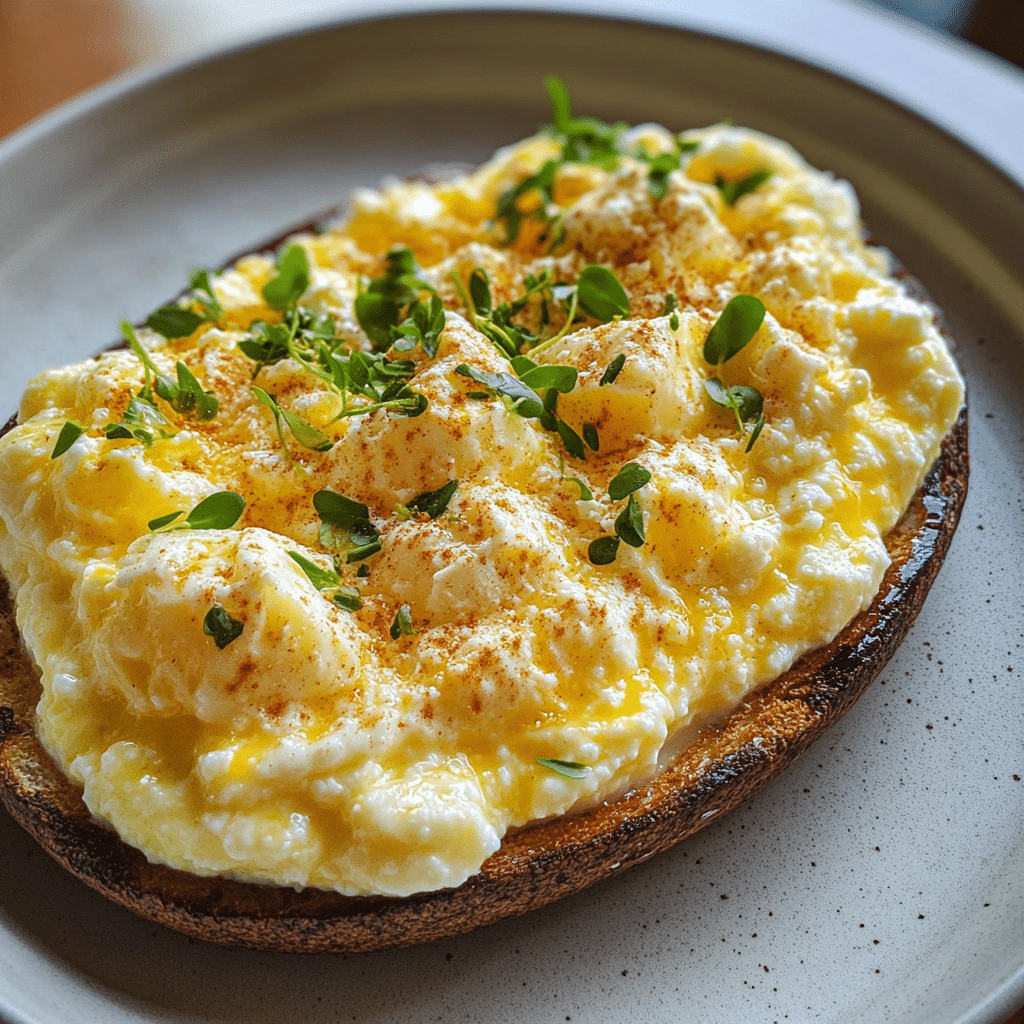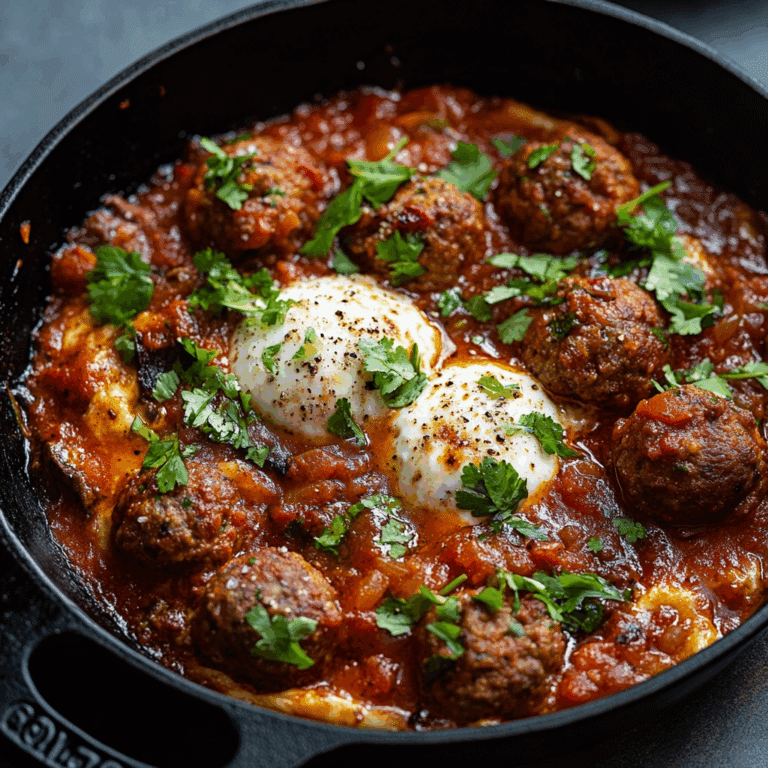Why Cottage Cheese Eggs Make Breakfast Better

If you’re looking to revolutionize your breakfast routine, Cottage Cheese Eggs are about to become your new favorite. This simple yet brilliant dish combines the creamy tang of cottage cheese with fluffy eggs, creating a protein-packed meal that’s both satisfying and delicious. Whether you want to fuel a busy day or indulge in a comforting morning treat, this recipe adds a unique twist that will make breakfast better every time.
Why You’ll Love This Recipe
- Protein Powerhouse: Cottage Cheese Eggs pack a tremendous amount of protein, keeping you energized and full for longer.
- Rich Creaminess: The cottage cheese adds a luscious, velvety texture that makes every bite irresistibly soft.
- Easy and Quick: Whip up this dish in under ten minutes, perfect for busy mornings or lazy weekends.
- Versatile Flavor Base: This recipe pairs effortlessly with herbs, veggies, and spices to suit any taste preference.
- Gut-Friendly Ingredients: Cottage cheese offers probiotics that support digestion and overall gut health.
Ingredients You’ll Need
The ingredients for Cottage Cheese Eggs are refreshingly simple, each one adding its own essential element to flavor, texture, and nutritional value. You don’t need anything fancy to pull this off, just good basics that work beautifully together.
- Eggs: The star protein source and base of the dish that create the fluffy texture.
- Cottage Cheese: Adds creaminess and tang along with a hit of protein and calcium.
- Salt and Pepper: Basic seasonings to enhance the natural flavors without overpowering.
- Butter or Oil: For cooking, adding richness and preventing sticking.
- Fresh Herbs (optional): Chives, parsley, or dill bring brightness and fresh aroma to the dish.
Variations for Cottage Cheese Eggs
Part of the joy in making Cottage Cheese Eggs is how effortlessly you can customize it to suit your mood or dietary needs. Let your creativity run with these easy variations that add new dimensions to this classic dish.
- Veggie Boost: Toss in chopped spinach, tomatoes, or bell peppers to up your vitamin intake and add color.
- Spicy Twist: Add a pinch of chili flakes or a splash of hot sauce for those who crave some heat.
- Herbal Infusion: Experiment with basil, thyme, or cilantro for a fresh aromatic touch.
- Cheesy Upgrade: Mix in shredded cheddar or mozzarella for an extra cheesy experience.
- Dairy-Free Version: Substitute cottage cheese with mashed avocado or tofu for a vegan-friendly option.

How to Make Cottage Cheese Eggs
Step 1: Crack and Whisk the Eggs
Start by cracking your eggs into a bowl, then whisk them gently until the yolks and whites are fully combined and slightly frothy. This step injects air, helping the eggs turn nice and fluffy.
Step 2: Add Cottage Cheese
Stir in the cottage cheese into your whisked eggs. It’s the magic ingredient that brings creamy smoothness and a subtle tang that elevates the dish far beyond plain scrambled eggs.
Step 3: Season the Mixture
Add a pinch of salt and freshly ground black pepper to taste. Feel free to toss in chopped herbs at this stage if you want fresh flavor embedded in every bite.
Step 4: Heat the Pan and Cook
Warm your skillet over medium-low heat and melt a little butter or add oil. Pour in the egg and cottage cheese mixture, letting it cook gently. Stir occasionally with a spatula, folding the mixture softly to preserve creaminess.
Step 5: Serve Immediately
Once the eggs are cooked but still moist and fluffy, remove from heat and serve without delay. Overcooking can rob the dish of its luxurious texture.
Pro Tips for Making Cottage Cheese Eggs
- Low and Slow: Cooking on low heat prevents the eggs from becoming rubbery and ensures creaminess.
- Fresh Cottage Cheese: Use full-fat and fresh cottage cheese for the best texture and flavor.
- Don’t Over-Stir: Gently fold rather than vigorously scramble for better texture.
- Season Gradually: Taste as you go to avoid over-salting, since cottage cheese can already be slightly salty.
- Prep Ingredients Ahead: Chop herbs or vegetables before starting for smooth cooking flow.
How to Serve Cottage Cheese Eggs
Garnishes
Sprinkle fresh chopped herbs like chives, parsley, or dill on top to add a fresh pop of color and brighten the rich flavors. A dash of smoked paprika or cracked pepper also adds visual appeal and subtle complexity.
Side Dishes
Cottage Cheese Eggs pair wonderfully with whole-grain toast, sautéed mushrooms, or avocado slices. For a heartier meal, grilled tomatoes or breakfast potatoes are perfect companions that round out the plate.
Creative Ways to Present
Serve your Cottage Cheese Eggs in a warm tortilla for a delicious breakfast wrap or spoon them over a toasted English muffin topped with smoked salmon for an elegant brunch twist. You can even pile them over mixed greens for a high-protein salad.
Make Ahead and Storage
Storing Leftovers
Place any leftover Cottage Cheese Eggs in an airtight container and refrigerate within two hours of cooking. They will stay fresh and tasty for up to two days, making them a convenient option for quick breakfasts or snacks.
Freezing
While we recommend enjoying Cottage Cheese Eggs fresh for the best texture, they can be frozen if necessary. Freeze in a sealed container for up to one month, but expect slight changes in texture upon thawing.
Reheating
Reheat gently in a skillet over low heat or microwave on a low power setting to warm without drying them out. Adding a splash of milk or a bit of butter can help restore creamy consistency.
FAQs
Can I use low-fat or non-fat cottage cheese?
Yes, but keep in mind that full-fat cottage cheese adds the creamiest texture and richest flavor, while low-fat options might make the eggs a bit drier.
Are Cottage Cheese Eggs suitable for a keto diet?
Absolutely! They are high in protein and fat, and low in carbs, making them an excellent keto-friendly breakfast option.
Can I add other cheeses to the recipe?
Yes, mixing in shredded cheeses like cheddar or mozzarella can enhance the flavor and create a gooey texture if you love extra cheesiness.
How do I prevent the eggs from sticking to the pan?
Use a non-stick skillet and cook on low heat with enough butter or oil, stirring gently to prevent sticking and maintain softness.
Is this dish good for kids?
Definitely! Cottage Cheese Eggs are mild, creamy, and packed with nutrients, making them a great breakfast choice for children.
Final Thoughts
If you haven’t tried Cottage Cheese Eggs yet, now’s the perfect time to give this deliciously creamy, protein-rich breakfast a go. It’s easy, versatile, and guaranteed to make your mornings better with every bite. Get cracking and enjoy the cozy, satisfying start your day deserves!
Related Posts
- Irresistible Cinnamon Roll French Toast Bites Recipe
- Why Amish Apple Fritter Bread Is Irresistible
- How to Make Air Fryer Cheesy Egg Toast Fast
Cottage Cheese Eggs
Cottage Cheese Eggs combine the creamy tang of cottage cheese with fluffy eggs for a protein-packed, delicious, and satisfying breakfast that’s quick and easy to make. Perfect for busy mornings or lazy weekends, this versatile dish offers a rich, velvety texture and can be customized with herbs, veggies, or spices to suit any taste.
- Prep Time: 5 minutes
- Cook Time: 5 minutes
- Total Time: 10 minutes
- Yield: 2 servings 1x
- Category: Breakfast
- Method: Stovetop Cooking
- Cuisine: American
- Diet: Gluten Free, Keto Friendly
Ingredients
Main Ingredients
- 4 large eggs
- 1/2 cup full-fat cottage cheese
- Salt, to taste
- Freshly ground black pepper, to taste
- 1 tablespoon butter or oil, for cooking
Optional Ingredients
- Fresh herbs (chives, parsley, dill), chopped
Instructions
- Crack and Whisk the Eggs: Start by cracking your eggs into a bowl, then whisk them gently until the yolks and whites are fully combined and slightly frothy. This step injects air, helping the eggs turn nice and fluffy.
- Add Cottage Cheese: Stir in the cottage cheese into your whisked eggs. It’s the magic ingredient that brings creamy smoothness and a subtle tang that elevates the dish far beyond plain scrambled eggs.
- Season the Mixture: Add a pinch of salt and freshly ground black pepper to taste. Feel free to toss in chopped herbs at this stage if you want fresh flavor embedded in every bite.
- Heat the Pan and Cook: Warm your skillet over medium-low heat and melt a little butter or add oil. Pour in the egg and cottage cheese mixture, letting it cook gently. Stir occasionally with a spatula, folding the mixture softly to preserve creaminess.
- Serve Immediately: Once the eggs are cooked but still moist and fluffy, remove from heat and serve without delay. Overcooking can rob the dish of its luxurious texture.
Notes
- Low and Slow: Cooking on low heat prevents the eggs from becoming rubbery and ensures creaminess.
- Fresh Cottage Cheese: Use full-fat and fresh cottage cheese for the best texture and flavor.
- Don’t Over-Stir: Gently fold rather than vigorously scramble for better texture.
- Season Gradually: Taste as you go to avoid over-salting, since cottage cheese can already be slightly salty.
- Prep Ingredients Ahead: Chop herbs or vegetables before starting for smooth cooking flow.
Nutrition
- Serving Size: 1 serving
- Calories: 220
- Sugar: 2g
- Sodium: 300mg
- Fat: 15g
- Saturated Fat: 7g
- Unsaturated Fat: 6g
- Trans Fat: 0g
- Carbohydrates: 3g
- Fiber: 0g
- Protein: 20g
- Cholesterol: 370mg
Keywords: cottage cheese eggs, protein-packed breakfast, creamy scrambled eggs, quick breakfast, keto breakfast, gluten free eggs







